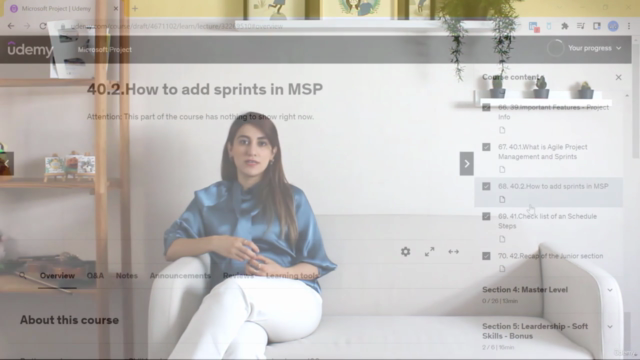Microsoft Project : MS Project + Soft Skills as BONUS Course

Why take this course?
This outline appears to be a comprehensive curriculum for learning Microsoft Project at an advanced level, tailored for professionals who are looking to enhance their scheduling and project management skills. The curriculum is structured into several key areas:
-
Understanding the Interface and Basics: This section likely covers the basic navigation of MS Project and understanding its interface. It includes setting up a new project, defining project options, and understanding the calendar settings.
-
Project Structure: Here, you would learn about Work Breakdown Structures (WBS), activities, and how to integrate them into MS Project. You would also understand what milestones are and how to insert them.
-
Duration, Effort, Elapsed Time: This part focuses on understanding activity durations, setting them in the project plan, and the differences between duration, effort, and elapsed time.
-
Relationships: Understanding how tasks relate to each other is crucial. This section covers different types of relationships, how to set them up, and how to analyze them.
-
Milestone Planning: This involves understanding what milestones are, when and how to plan for them in your project timeline.
-
Resources: Learning how to insert resources into your project, assign tasks to them, manage resource allocation, and deal with resource overallocation.
-
Units of Work: Understanding work units, duration units, and task types.
-
Task Types and % Complete: This section deals with understanding different task types and how to track progress using percentage complete.
-
Budgeting: Learning about cost estimates, unit costs, and linking man-hours to costs.
-
Baseline and Status Date: Setting up a baseline for comparison throughout the project, understanding the status date, and its importance in reporting progress.
-
Reporting: This is where you learn how to create reports within MS Project and in Excel, including junior, senior, and master-level reporting techniques.
-
Filter-Highlight-Layout Views: Learning to use these views for better visualization and data analysis.
-
S-Curve Analysis: Understanding the S-Curve or resource loading graph and how it helps in project monitoring.
-
Earned Value Management (EVM): This section teaches you EVM, Cost Performance Index (CPI), and Schedule Performance Index (SPI), and how to calculate them to assess project performance.
-
Rebaselining: Learning how to adjust the baseline based on changes in the project scope or schedule.
-
Schedule Analysis: Analyzing the schedule to identify issues and make recommendations for improvement.
-
Soft Skills: As scheduling is not just about technical skills, this bonus section covers leadership, communication, teamwork, effective meetings, forecasting, and stakeholder management.
The course also emphasizes the importance of continuous support and updates to ensure that the information provided remains relevant and helpful. It seems designed to provide a well-rounded education in both the technical aspects of MS Project and the soft skills necessary for successful project management and leadership.
Course Gallery




Loading charts...